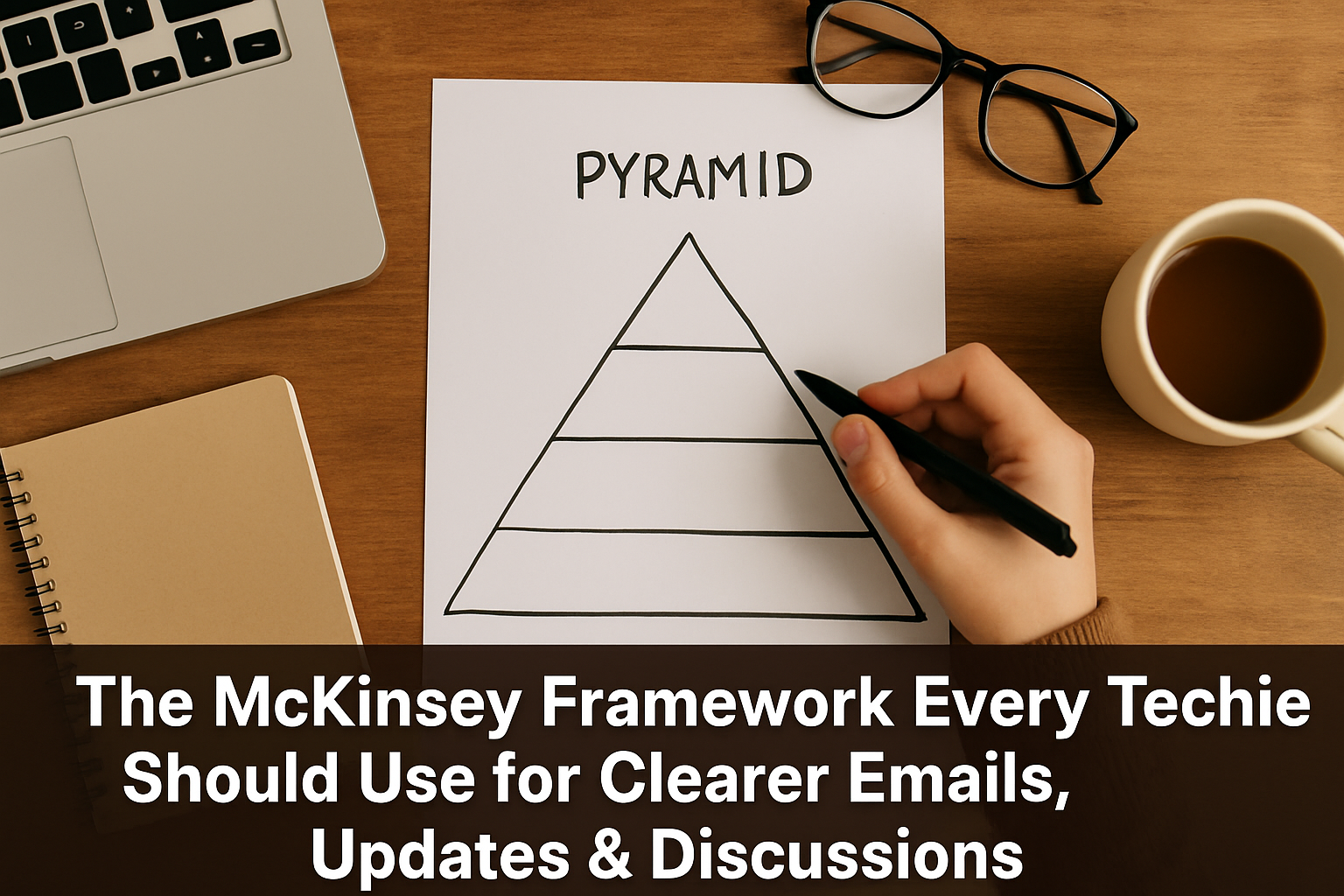The McKinsey Framework Every Techie Should Use for Clearer Emails, Updates & Proposals
Struggling with unclear emails or updates? Learn how techies can use McKinsey’s Pyramid Principle to write with clarity and impact.

In the IT world, communication can feel like an afterthought.
We obsess over design patterns, deployment pipelines, and database optimization.
But when it comes to updating stakeholders or writing a proposal?
It's often a chaotic brain dump.
And that’s exactly where the biggest risk lies.
Because if you’re a tech lead, architect, product owner, or even a BA — your ideas don’t get executed based on how smart you are.
They move forward based on how clearly you communicate them.
One of the most powerful techniques to structure your message comes from McKinsey — the global consulting powerhouse known for making complexity simple.
🎯 It’s called The Pyramid Principle — and it might just transform the way you write at work.
Let’s unpack it with real examples, clear takeaways, and a simple way to make it part of your communication toolkit.
The Everyday Pain in Tech Communication
Imagine this scenario. You're a solution architect, and you need to explain to the business stakeholders why you're proposing a new image optimization tool for the e-commerce platform.
You send this email:
Subject: Regarding media optimization tool
We’ve been seeing issues with page load times, especially for product images. The frontend team reported that image sizes are inconsistent, and there’s no standard compression. Users on mobile networks are facing delays. Dev team suggested using Cloudinary, which offers transformation APIs and auto-scaling. We need to discuss pricing and whether it fits our budget.
What happens?
- Business team gets confused.
- You get multiple calls asking, “What’s the problem exactly?”
- The final approval takes 2 weeks.
- You repeat the same explanation again — this time, over a call.
Sound familiar?
That email wasn't wrong — but it wasn’t structured.
It forced the reader to dig for the point.
And in high-stakes environments, that’s deadly.
What Is the Pyramid Principle?
Developed by Barbara Minto at McKinsey, the Pyramid Principle is simple:
Start with the answer. Then support it with arguments. Then back those with evidence.
Like a pyramid:

This structure flips the traditional way tech people write:
- We usually explain all the background…
- …then the detail…
- …then the conclusion.
But business people?
They need clarity — fast.
Their attention span is short. Their decisions are urgent.
Rewriting the Email Using Pyramid Principle
Let’s rewrite the earlier email using the Pyramid format.
Subject: Proposal – Use Cloudinary for Product Image Optimization
Hi Team,
To improve product page load speed — I propose we adopt Cloudinary as our image optimization tool.
Why:
- Average image size is ~1.2 MB, impacting mobile load times
- Current CMS doesn’t support responsive image delivery
- Cloudinary offers auto-scaling and CDN support with minimal integration effort
Impact:
- Estimated 40% reduction in page load time (based on dev tests)
- Improved SEO scores & user experience
Next Steps:
- Finance team to review Cloudinary's pricing (₹5,000/month)
- If approved, we can integrate within 1 sprint
Thanks,
[Your Name]
Notice the difference?
💡 It doesn’t just dump information — it guides the reader through it.
Where the Pyramid Principle Fits in IT
You don’t need to be a consultant to use it.
You just need to write with a bit more intention.
Here’s where the Pyramid structure can be a game-changer in IT:
1. Stakeholder Emails
Stop writing status updates like a code log.
Start with the bottom line: what’s done, what’s delayed, what’s blocked — then explain why.
2. Design Documents
Instead of 10 pages of rambling explanation, begin with:
“We recommend Option B because it balances performance and maintainability. Here’s how we compared A, B, and C.”
It shows you’re not just building — you’re thinking.
3. Tool or Vendor Justification
Instead of starting with technical jargon, open with:
“To reduce downtime during deployments, we propose switching to Tool X. Here’s the cost-benefit.”
That’s what decision-makers need.
4. Escalations
When raising production issues, don’t start with logs and tracebacks.
Start with:
“We’re seeing 5% of users getting error 500 due to DB lock. Fix ETA: 2 hours. Here’s what we’ve done so far.”
It builds instant trust.
But Why Is It So Effective?
Let’s break it down.
🧠 Cognitive Ease
Our brains are wired to process structured input better.
Just like we prefer organized code blocks — we prefer structured messages.
🕑 Time-Saving
Busy leaders don’t want to read everything.
They want the “so what?” first. If it’s relevant, they’ll read more.
🔁 Reusability
Once you structure your thought, the same message can be reused:
- In a deck
- In a Slack thread
- In a verbal update
The pyramid becomes your thinking skeleton.
The Pyramid Is Not a Template — It’s a Thinking Tool
Let’s be clear.
It’s not about writing fancy language.
It’s about thinking in terms of:
- What’s the main point?
- Why is that the right point?
- What data or facts support this?
And once you do that — writing becomes 3x faster.
How to Start Using the Pyramid Today
Don’t wait for the perfect moment.
Try it in your very next update. Here’s how:
✍️ Step-by-Step Mini Framework
- Write the conclusion first
What is the message you want them to remember? - List 2–3 reasons supporting it
Why is this the right action / idea / insight? - Add evidence
What metric, fact, or test result backs it? - Trim & restructure
Turn each point into a short para or bullet. - Add a title/subject that signals the core idea
No vague subject lines like “Update.”
When to NOT Use It
There are rare moments when you should avoid it:
- Exploratory brainstorming: You’re not ready to conclude yet.
- Sensitive feedback: You want to ease into a tough message.
- Collaborative chats: You’re thinking with someone, not for them.
But for 80% of your work comms — it fits beautifully.
Final Thoughts: Think Like a Communicator, Not Just a Coder
You might be the smartest tech person in the room.
But if your message can’t travel — your value doesn’t scale.
And as you grow in your role, communication becomes your primary output.
Not code. Not configs. Not Jira tickets.
The Pyramid Principle is not just about writing well.
It’s about thinking clearly. And in IT, that’s what drives trust.
So whether you’re proposing a new tool, sending a weekly update, or influencing a roadmap — try the pyramid.
Start with the answer.
Then support it.
And watch your credibility — and impact — grow.
Structured writing is not decoration — it’s infrastructure.
💬 Let’s Connect
Enjoyed this article or have a perspective to share? Let’s connect on LinkedIn.

